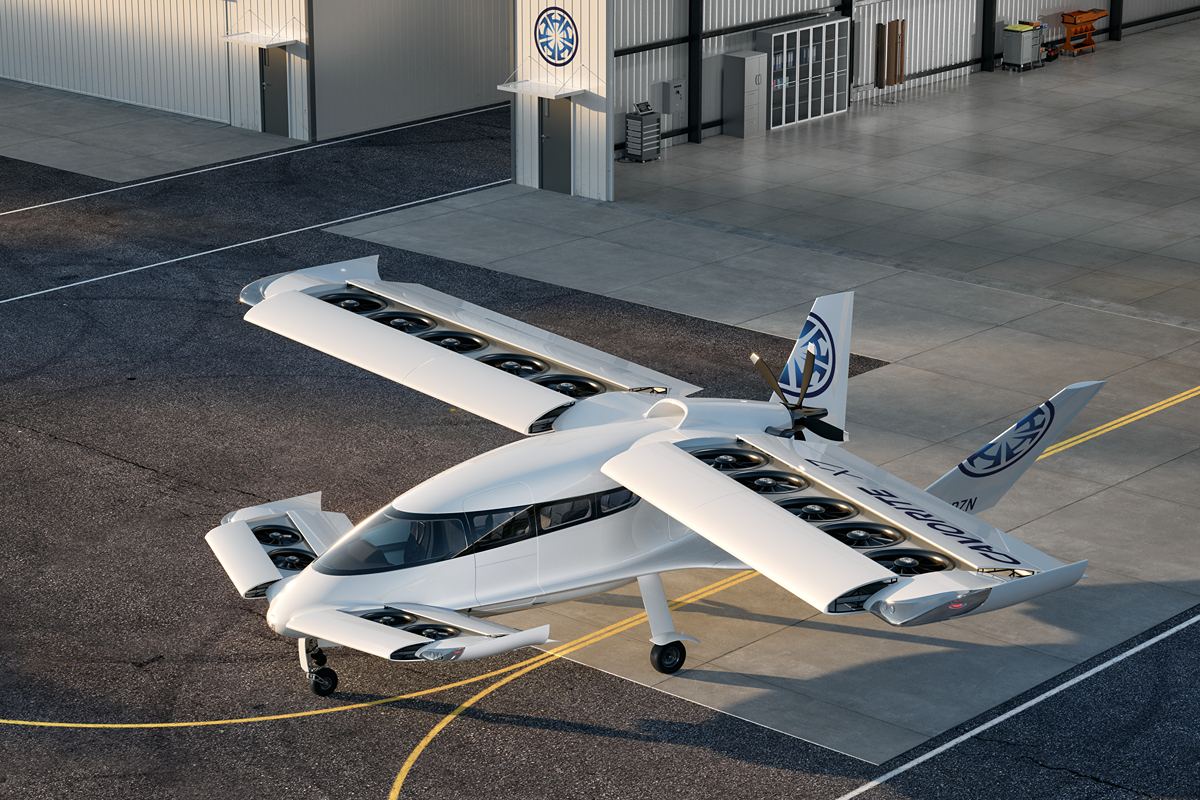Canadian-based Horizon Aircraft, an advanced aerospace engineering company which is currently developing what will become one of the world’s first hybrid eVTOL aircraft, announced on May 15, 2025, that the large-scale test prototype of its Cavorite X7 aircraft has achieved its first full-wing transition, successfully making the transition from vertical to forward flight – a major milestone in the development of any VTOL (Vertical Take-off and Landing) aircraft.
The Cavorite X7, named after the fictional gravity-defying material in H.G. Wells’ 1901 novel ‘The First Men in the Moon’, is a hybrid eVTOL aircraft that combines a conventional aero engine with battery-powered wing-based fans. It features a forward-swept main wing, plus a smaller set of horizontal canard-style stabilizers mounted on the forward fuselage. The aircraft also has twin-boom vertical stabilizers to the rear and a monocoque cabin that can accommodate up to six passengers, plus the operating pilot.
The key difference between the Cavorite X7 versus other eVTOL aircraft currently under development is that, while exposed rotors are the primary source of vertical thrust in those aircraft, the Cavorite X7 uses electrically-driven hidden fans embedded within the swept wing structures to provide vertical lift – a system referred to by the company as its patented ‘HOVR Wing’ design. This unique ‘fan-in-wing’ design combines the agility and versatility of a helicopter with the speed and strength of a conventional aircraft, states the company.
“Today, we join a very small group of companies worldwide that have achieved this critical technical milestone,” said Brandon Robinson, CEO and co-founder of Horizon Aircraft. “From the beginning, we have focused on innovations that make the most operational sense with the best available technology. We are looking forward to proving this next on our full-scale, piloted technical demonstrator that is currently under construction.”
“This incredible achievement validates our unique and robust approach to the transition phase of flight,” added Brian Robinson, chief engineer and co-founder. “In our aircraft, the transition phase was designed from the beginning to be a non-event, as there are no complicated multi-copter rotating nacelles or heavy tilt-wing mechanisms, and we have multiple layers of redundancy.”
“The result is an extremely safe and stable transition, a vital part of eVTOL operations, and an area in which many of our competitors have faced serious challenges,” he concluded.
According to a company statement, Horizon Aircraft’s patented fan-in-wing technology “is based on proven technology that leverages the advantages of modern electric motors and batteries to create a next-generation eVTOL system that enables a simpler, safer, and more efficient way to fly. With projected en-route speeds up to 250 mph and operational ranges over 500 miles with fuel reserves, the hybrid electric Cavorite X7 aims to be a disruptive force in the emerging Regional Air Mobility (RAM) market.”
Following the successful first transition to full horizontal flight and describing the event of the first full-wing transition flight, Brandon Robinson added to his LinkedIn profile that, “[Friday, May 9, 2025], was a good day for Horizon Aircraft. We became the first company to transition a fan-in-wing VTOL aircraft to forward flight using a novel architecture, and the second ever in history to accomplish this task. It was a boring flight, and in flight testing, boring is great!”
“The aircraft is rock solid during transition. No complex rotating nacelles/motors. No huge tilting wings. No pitch problems. No altitude loss. Just some panels sliding closed – working similarly to modern flaps and slats on every commercial airliner. I am extremely proud and humbled by our world-class team that is achieving this type of success. Now we move fully onto developing our full-scale aircraft, so stay tuned!”
More about the Cavorite X7
Capable of carrying out stage lengths of up to 500 miles (800km) while cruising at a speed of up to 250 knots (450 km/h), the Cavorite X7 can carry payloads up to 680kg (1500 lbs) if operating in vertical flight mode. This increases to 815kg (1,800 lbs) if flying purely in conventional flight mode, using runways to take off and land. The maximum gross weight of the aircraft is stated as 2,500kg (5,500 lbs).
Just a few days after Horizon’s first full-wing transition flight, UK-based eVTOL developer Vertical Aerospace announced it would also be joining Horizon in the hybrid arena with a new hybrid version of its VX4 eVTOL vehicle, recognising the need for such eVTOL aircraft to offer extended range capabilities that the current range of true eVTOL aircraft being developed cannot.




